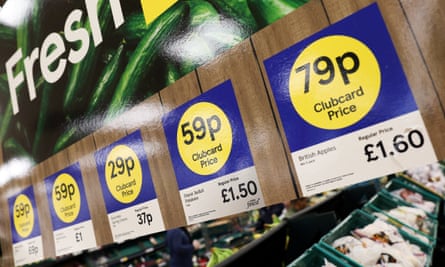The competition watchdog is to investigate the effect on consumers of the rise of loyalty card price cuts amid concerns that they could limit competition and lead to price rises for shoppers not signed up to such marketing schemes.
Sainsbury’s began offering special discounts for its Nectar card holders in April when the Co-op also brought in members’ pricing on some products, while Tesco has ramped up use of its Clubcard discounts this year. Lidl launched a loyalty scheme in 2020 and updated it last year so that shoppers had to spend more to get the top level of discounts.
Tesco has more than 8,000 products that are cheaper for holders of its Clubcard, while Sainsbury’s has about 6,000 items in its Nectar scheme. A typical large supermarket would stock more than 20,000 products.
Shoppers are increasingly using the cards as household budgets get squeezed; 90% of consumers are signed up to at least one such scheme.
The Competition and Markets Authority (CMA) said the schemes could make it difficult for shoppers to compare prices between supermarkets, as the per-weight price of goods is often not shown on the loyalty card promotions.
On Wednesday, Tesco was offering Clubcard holders a pack of Pampers nappies for £6 for those on the loyalty scheme – a 40% reduction compared with the £10 price for regular shoppers. At Sainsbury’s, Nectar members can get a leg of lamb at half the price paid by regular shoppers, at £13.
The watchdog will also examine if the loyalty schemes reduce competition, by being “difficult or time-consuming to sign up to”, which could inhibit switching between chains.
Sarah Cardell, the chief executive of the CMA, said: “We have seen an increase in the use of loyalty scheme pricing by supermarkets, which means that price promotions are only available to people who sign up for loyalty cards.
“This raises a number of questions about the impact of loyalty scheme pricing on consumers and competition, and the CMA will launch a review in January 2024.”
However, the regulator said it had not seen evidence to suggest that the schemes were likely to have a material impact on the strength of competition between retailers.
 View image in fullscreenClubcard discounts advertised at a branch of Tesco. Photograph: Paul Childs/Reuters
View image in fullscreenClubcard discounts advertised at a branch of Tesco. Photograph: Paul Childs/Reuters
Consumer group Which? said it had asked the regulator to look at whether supermarkets could be raising “regular” prices to make it appear that loyalty scheme customers are getting a better deal than they really are.
Sue Davies, the head of food policy at Which?, said: “It’s positive that the CMA is set to review supermarket loyalty pricing, as a recent Which? investigation found these deals aren’t always as they seem.”
The Which? study found that a third of the products it examined at Sainsbury’s (34% of 71 products) had only been at the “regular” price advertised beside the Nectar deal for less than half the time over the previous six months. At Tesco, it was a quarter of the products examined.
The consumer group also pointed out that the schemes are not accessible to all shoppers. Only those 18 or over can be a member of the Asda, Iceland, Lidl, M&S, Sainsbury’s, Tesco, and Waitrose loyalty schemes, and those over 16 at Morrisons. The Co-op is the only large supermarket currently offering a scheme for under-16s.
Some schemes also require an email address or an app, potentially making them less accessible for older and more vulnerable shoppers. The Sainsbury’s price-cutting scheme does not operate in its convenience stores, which are often used by those on low incomes without access to a car or public transport.
Danni Hewson, head of financial analysis at AJ Bell, said: “People should feel confident that they’re getting what they pay for and that they are not paying more than they should for the privilege. They shouldn’t have to visit several different stores using several different loyalty cards just to make sure they’re getting as much for their money as they can.”
On Wednesday, the CMA also said that makers of popular brands in lines such as baby milk, baked beans, mayonnaise and pet food had fuelled “greedflation” by putting up prices faster than their costs had risen.



